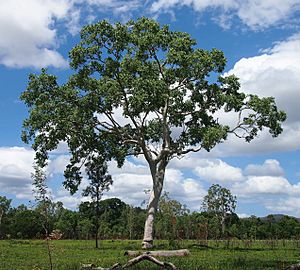Poplar gum facts for kids
Quick facts for kids Poplar gum |
|
|---|---|
 |
|
| Scientific classification | |
| Genus: |
Eucalyptus
|
| Species: |
platyphylla
|
The Poplar Gum, also known as white gum, is a special kind of tree found only in Queensland, Australia. It's a medium-sized tree with smooth, powdery bark. You can spot it by its unique heart-shaped or round leaves, white flowers, and fruit that looks like a small cone.
Contents
What Does the Poplar Gum Look Like?
The Poplar Gum is a tree that usually grows up to 20 m (66 ft) tall. That's about as tall as a six-story building! It has smooth bark that feels powdery and can be pale pink or greenish-white.
When the tree is young, or if new shoots grow from its base (called a lignotuber), its leaves are shaped like a triangle. These young leaves can be quite large, from 90 mm (3.5 in) to 200 mm (7.9 in) long and 60 mm (2.4 in) to 165 mm (6.5 in) wide.
As the tree gets older, its leaves change. Adult leaves are a dull grayish-green on both sides. They can be heart-shaped, egg-shaped, or almost perfectly round. These leaves are 50 mm (2.0 in) to 210 mm (8.3 in) long and 35 mm (1.4 in) to 120 mm (4.7 in) wide. Each leaf has a stem, called a petiole, which is 25 mm (0.98 in) to 70 mm (2.8 in) long.
The Poplar Gum's flower buds grow in groups of seven. They are found where the leaf meets the stem (called an axil). These groups of buds sit on a small stalk, or peduncle, which is 3 mm (0.12 in) to 8 mm (0.31 in) long. Some buds sit directly on the stalk, while others have tiny stems, called pedicels, up to 6 mm (0.24 in) long.
When the buds are ready to open, they are oval or almost round. They are 6 mm (0.24 in) to 9 mm (0.35 in) long and 5 mm (0.20 in) to 7 mm (0.28 in) wide. Each bud has a cap, called an operculum, which can be rounded or cone-shaped.
The Poplar Gum blooms with white flowers from June to October. After the flowers, the tree produces woody fruits. These fruits are shaped like a cone or half-sphere and are 3 mm (0.12 in) to 6 mm (0.24 in) long and 6 mm (0.24 in) to 10 mm (0.39 in) wide. They have small openings, called valves, that are usually even with the rim or stick out a little.
How Did the Poplar Gum Get Its Name?
The scientific name for Poplar Gum is Eucalyptus platyphylla. It was first officially described in 1859 by a famous botanist named Ferdinand von Mueller. He wrote about it in a science journal called Journal of the Proceedings of the Linnean Society, Botany. He found the tree near the Burdekin River in Queensland.
The second part of its scientific name, platyphylla, comes from ancient Greek words. "Platy" means "flat," "wide," or "broad," and "phylla" means "leaved." So, the name platyphylla simply means "broad-leaved," which describes its wide leaves perfectly!
Where Does the Poplar Gum Live?
The Poplar Gum mostly grows within 100 km (62 mi) of the coast in Queensland, Australia. It likes to live in soils that often stay wet for a long time. You can find these trees all the way from Horn Island in the Torres Strait down to the area near Rockhampton.
Is the Poplar Gum Safe?
Good news! The Poplar Gum is not currently in danger. The Queensland Government lists this eucalypt as "least concern" under their Nature Conservation Act 1992. This means there are plenty of Poplar Gum trees around, and they are not at risk of disappearing anytime soon.


